Abstract
Radiochemical methodology has been used in the isolation and preliminary biochemical characterization of the murine H-2Ld major histocompatibility complex gene product. The radiolabeled molecule was isolated by immunoprecipitation from the glycoprotein fraction of detergent-solubilized H-2d tumor cells. Six major CNBr fragments were isolated from a papain fragment of this molecule; three of the fragments are connected by disulfide bonds. Due to the high degree of homology between major transplantation antigens, it was possible to align the fragments by comparison of their amino acid sequences to that of the H-2Kb gene product. Of the positions available for comparison between H-2Ld and H-2Kb, H-2Dd, and H-2Kd gene products, 61 out of 80 (78%), 45 out of 55 (82%), and 12 out of 15 (80%), respectively, are identical. Differences between the Ld and Kb and Dd molecules are distributed throughout the amino acid sequence. These data indicate that the H-2Ld gene product is a molecular species distinct from, but homologous to, the H-2K and H-2D gene products.
Full text
PDF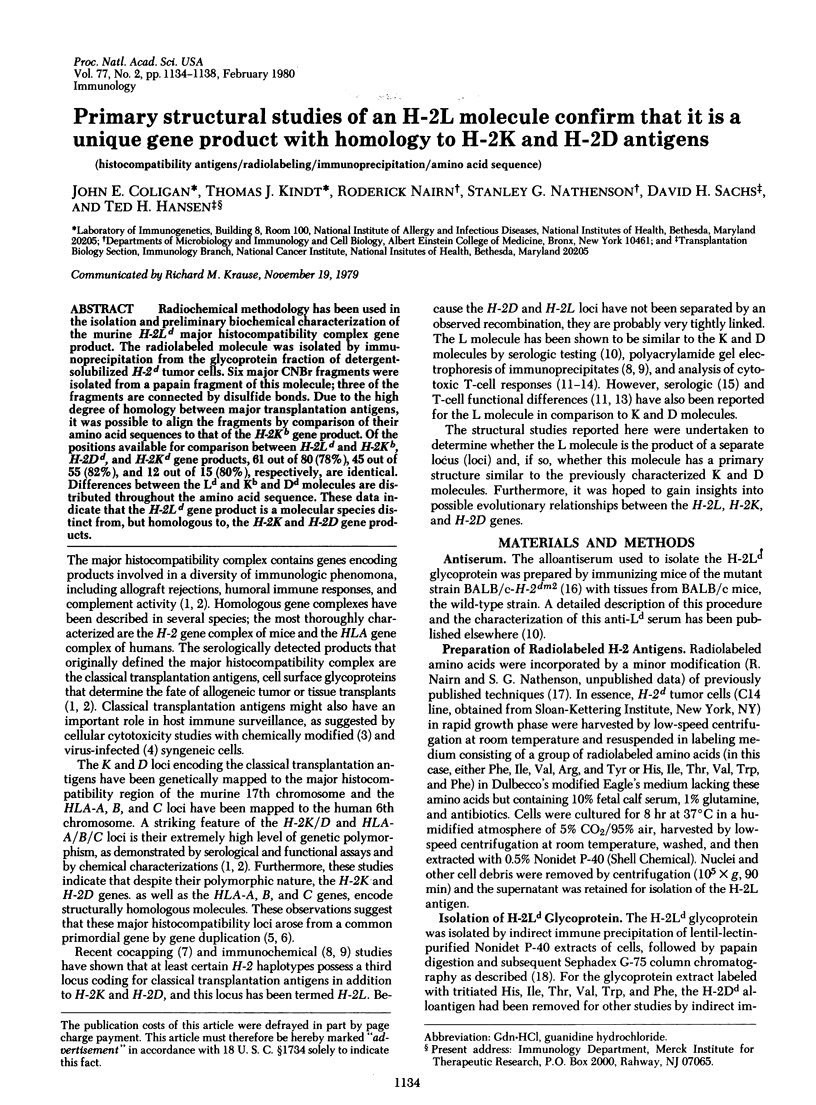
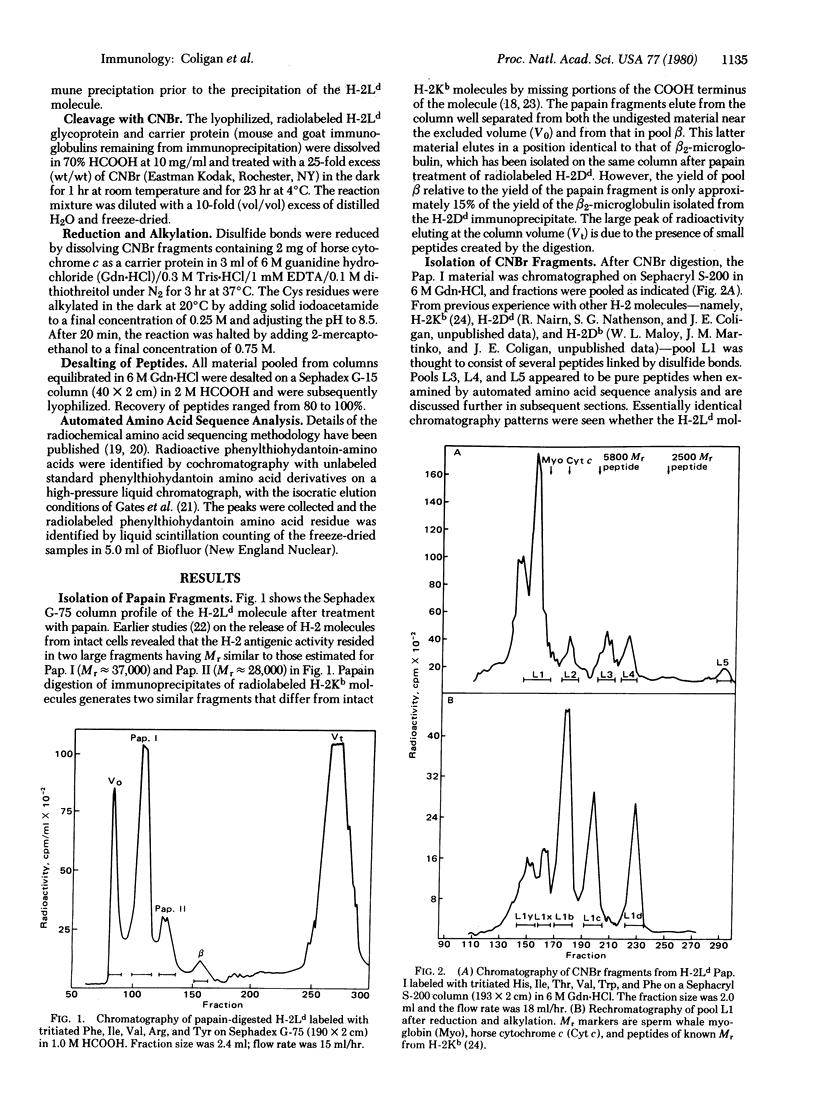
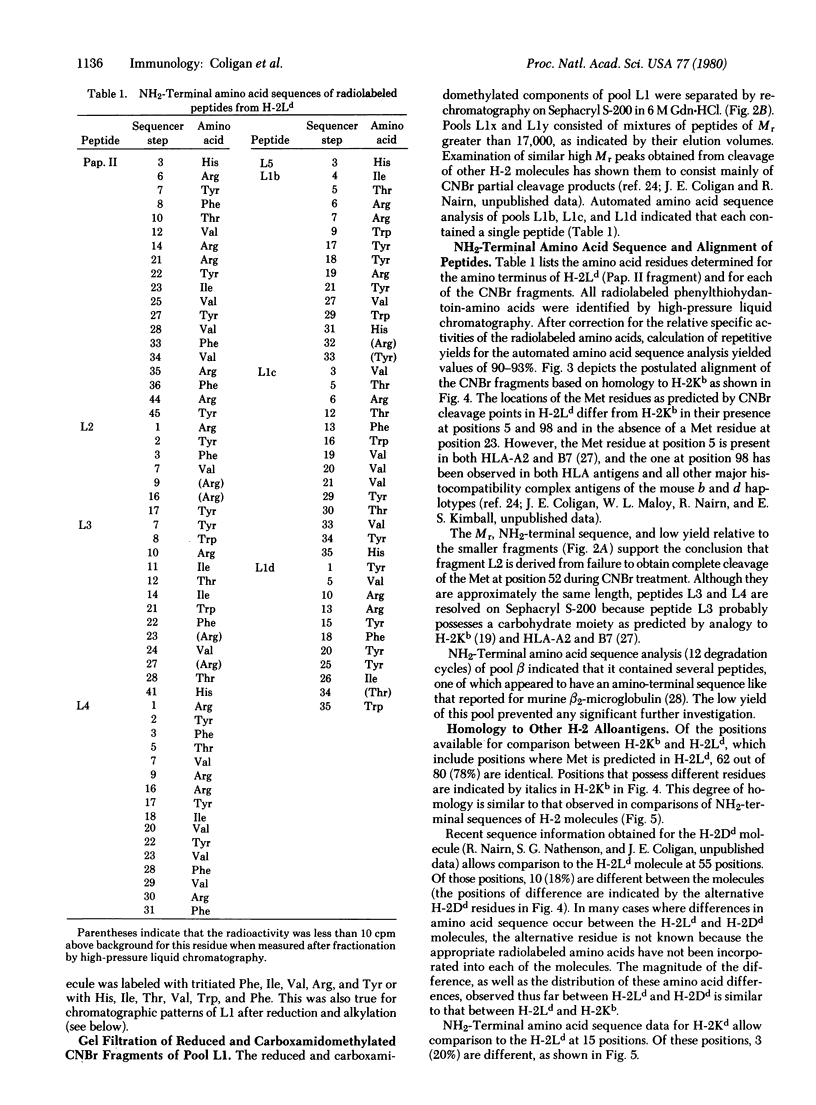
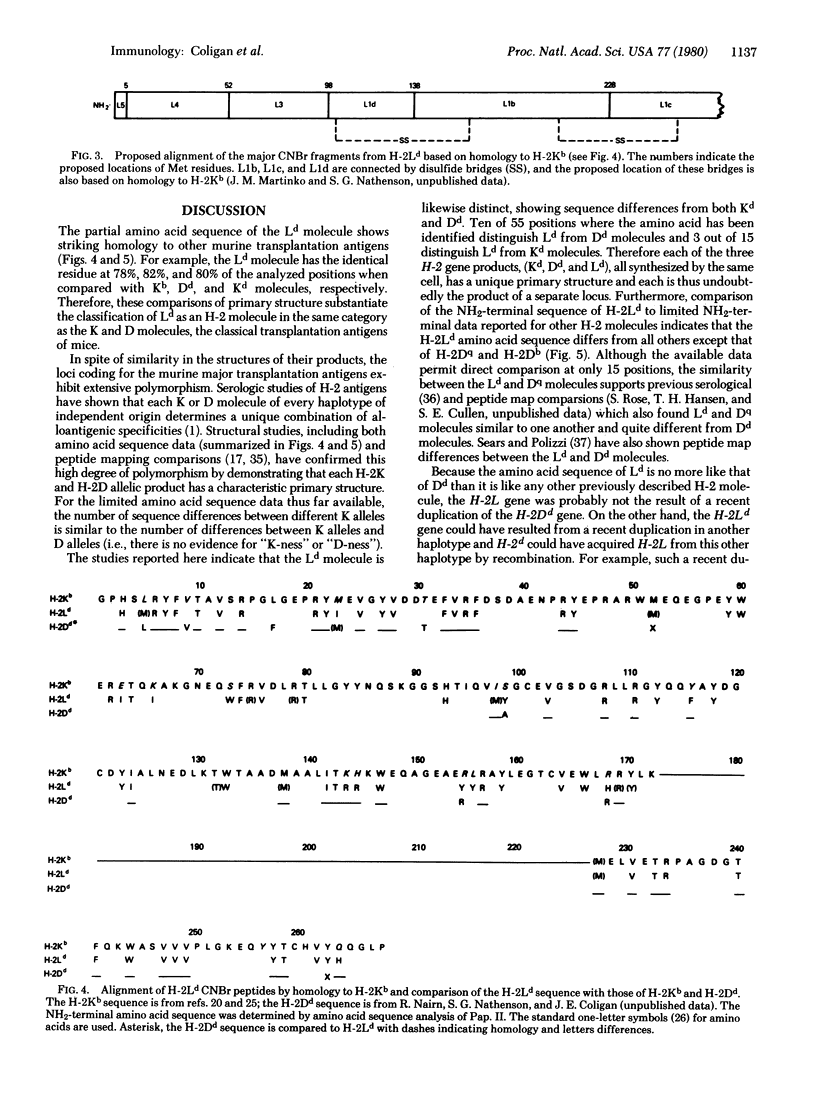
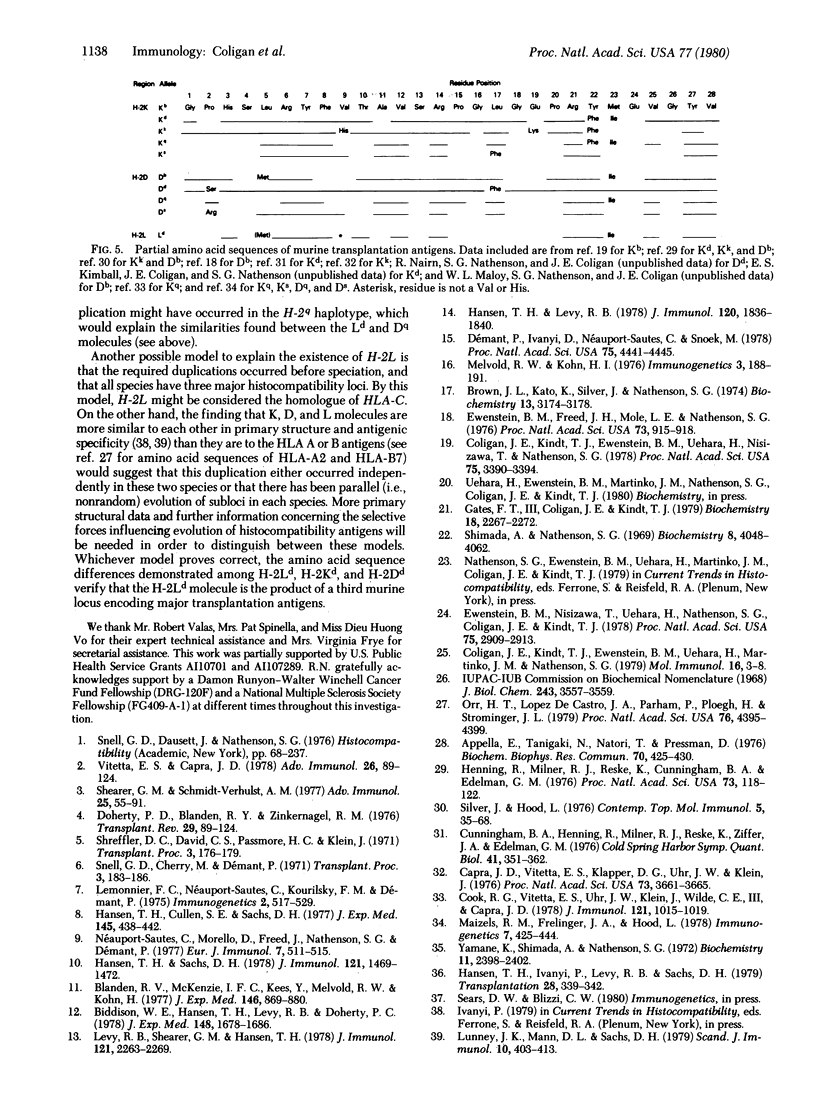
Selected References
These references are in PubMed. This may not be the complete list of references from this article.
- Appella E., Tanigaki N., Natori T., Pressman D. Partial amino acid sequence of mouse beta2-microglobulin. Biochem Biophys Res Commun. 1976 May 17;70(2):425–430. doi: 10.1016/0006-291x(76)91063-9. [DOI] [PubMed] [Google Scholar]
- Biddison W. E., Hansen T. H., Levy R. B., Doherty P. C. Involvement of H-2L gene products in virus-immune T-cell recognition. Evidence for an H-2L-restricted T-cell response. J Exp Med. 1978 Dec 1;148(6):1678–1686. doi: 10.1084/jem.148.6.1678. [DOI] [PMC free article] [PubMed] [Google Scholar]
- Blanden R. V., McKenzie I. F., Kees U., Melvold R. W., Kohn H. I. Cytotoxic T-cell response to Ectromelia virus-infected cells. Different H-2 requirements for triggering precursor T-cell induction or lysis by effector T cells defined by the BALB/c-H-2db mutation. J Exp Med. 1977 Sep 1;146(3):869–880. doi: 10.1084/jem.146.3.869. [DOI] [PMC free article] [PubMed] [Google Scholar]
- Brown J. L., Kato K., Silver J., Nathenson S. G. Notable diversity in peptide composition of murine H-2K and H-2D alloantigens. Biochemistry. 1974 Jul 16;13(15):3174–3178. doi: 10.1021/bi00712a027. [DOI] [PubMed] [Google Scholar]
- Capra J. D., Vitetta E. S., Klapper D. G., Uhr J. W., Klein J. Structural studies on protein products of murine chromosome 17: partial amino acid sequence of an H-2Kb molecule. Proc Natl Acad Sci U S A. 1976 Oct;73(10):3661–3665. doi: 10.1073/pnas.73.10.3661. [DOI] [PMC free article] [PubMed] [Google Scholar]
- Coligan J. E., Kindt T. J., Ewenstein B. M., Uehara H., Martinko J. M., Nathenson S. G. Further structural analysis of the murine H-2Kb glycoprotein using radiochemical methodology. Mol Immunol. 1979 Jan;16(1):3–8. doi: 10.1016/0161-5890(79)90021-x. [DOI] [PubMed] [Google Scholar]
- Coligan J. E., Kindt T. J., Ewenstein B. M., Uehara H., Nisizawa T., Nathenson S. G. Primary structure of murine major histocompatibility complex alloantigens: amino acid sequence studies of the cyanogen bromide fragments of the H-2Kb glycoprotein. Proc Natl Acad Sci U S A. 1978 Jul;75(7):3390–3394. doi: 10.1073/pnas.75.7.3390. [DOI] [PMC free article] [PubMed] [Google Scholar]
- Cook R. G., Vitetta E. S., Uhr J. W., Klein J., Wilde C. E., 3rd, Capra J. D. Structural studies on protein products of murine chromosome 17. III. Partial amino acid sequence of an H-2Kq molecule. J Immunol. 1978 Sep;121(3):1015–1019. [PubMed] [Google Scholar]
- Cunningham B. A., Henning R., Milner R. J., Reske K., Ziffer J. A., Edelman G. M. Structure of murine histocompatibility antigens. Cold Spring Harb Symp Quant Biol. 1977;41(Pt 1):351–362. doi: 10.1101/sqb.1977.041.01.042. [DOI] [PubMed] [Google Scholar]
- Doherty P. C., Blanden R. V., Zinkernagel R. M. Specificity of virus-immune effector T cells for H-2K or H-2D compatible interactions: implications for H-antigen diversity. Transplant Rev. 1976;29:89–124. doi: 10.1111/j.1600-065x.1976.tb00198.x. [DOI] [PubMed] [Google Scholar]
- Démant P., Iványi D., Neauport-Sautes C., Snoek M. H-2.28, an alloantigenic marker allelic to H-2.1, is expressed on all three known types of H-2 molecules. Proc Natl Acad Sci U S A. 1978 Sep;75(9):4441–4445. doi: 10.1073/pnas.75.9.4441. [DOI] [PMC free article] [PubMed] [Google Scholar]
- Ewenstein B. M., Freed J. H., Mole L. E., Nathenson S. G. Localization of the papain cleavage site of H-2 glycoproteins. Proc Natl Acad Sci U S A. 1976 Mar;73(3):915–918. doi: 10.1073/pnas.73.3.915. [DOI] [PMC free article] [PubMed] [Google Scholar]
- Ewenstein B. M., Nisizawa T., Uehara H., Nathenson S. G., Coligan J. E., Kindt T. J. Primary structure of murine major histocompatibility complex alloantigens: isolation, biochemical characterization, and preliminary alignment of CNBr fragments from the H-2Ib glycoprotein. Proc Natl Acad Sci U S A. 1978 Jun;75(6):2909–2913. doi: 10.1073/pnas.75.6.2909. [DOI] [PMC free article] [PubMed] [Google Scholar]
- Gates F. T., 3rd, Coligan J. E., Kindt T. J. Complete amino acid sequence of rabbit beta 2-microglobulin. Biochemistry. 1979 May 29;18(11):2267–2272. doi: 10.1021/bi00578a021. [DOI] [PubMed] [Google Scholar]
- Hansen T. H., Cullen S. E., Sachs D. H. Immunochemical evidence for an additional H-2 region closely linked to H-2D. J Exp Med. 1977 Feb 1;145(2):438–442. doi: 10.1084/jem.145.2.438. [DOI] [PMC free article] [PubMed] [Google Scholar]
- Hansen T. H., Ivanyi P., Levy R. B., Sachs D. H. Cross-reactivity among the products of three nonallelic H-2 loci, H-2Ld, H-2Dq, and H-2Kk. Transplantation. 1979 Oct;28(4):339–342. doi: 10.1097/00007890-197910000-00015. [DOI] [PubMed] [Google Scholar]
- Hansen T. H., Levy R. B. Alloantigens determined by a second D region locus elicit a strong in vitro cytotoxic response. J Immunol. 1978 Jun;120(6):1836–1840. [PubMed] [Google Scholar]
- Hansen T. H., Sachs D. H. Isolation and antigenic characterization of the product of a third polymorphic H-2 locus, H-2L. J Immunol. 1978 Oct;121(4):1469–1472. [PubMed] [Google Scholar]
- Henning R., Milner R. J., Reske K., Cunningham B. A., Edelman G. M. Subunit structure, cell surface orientation, and partial amino-acid sequences of murine histocompatibility antigens. Proc Natl Acad Sci U S A. 1976 Jan;73(1):118–122. doi: 10.1073/pnas.73.1.118. [DOI] [PMC free article] [PubMed] [Google Scholar]
- Levy R. B., Shearer G. M., Hansen T. D. Properties of H-2L locus products in allogeneic and H-2 restricted, trinitrophenyl-specific cytotoxic responses. J Immunol. 1978 Dec;121(6):2263–2269. [PubMed] [Google Scholar]
- Lunney J. K., Mann D. L., Sachs D. H. Sharing Ia antigens between species. III. Ia specificities shared between mice and human beings. Scand J Immunol. 1979;10(5):403–413. doi: 10.1111/j.1365-3083.1979.tb01369.x. [DOI] [PubMed] [Google Scholar]
- Neauport-Sautes C., Morello D., Freed J. H., Nathenson S. G., Démant P. The private specificity H-2.4 and the public specificity H-2.28 of the D region are expressed on two independent polypeptide chains. Eur J Immunol. 1977 Aug;7(8):511–515. doi: 10.1002/eji.1830070804. [DOI] [PubMed] [Google Scholar]
- Orr H. T., Lopez de Castro J. A., Parham P., Ploegh H. L., Strominger J. L. Comparison of amino acid sequences of two human histocompatibility antigens, HLA-A2 and HLA-B7: location of putative alloantigenic sites. Proc Natl Acad Sci U S A. 1979 Sep;76(9):4395–4399. doi: 10.1073/pnas.76.9.4395. [DOI] [PMC free article] [PubMed] [Google Scholar]
- Shearer G. M., Schmitt-Verhulst A. M. Major histocompatibility complex restricted cell-mediated immunity. Adv Immunol. 1977;25:55–91. doi: 10.1016/s0065-2776(08)60931-1. [DOI] [PubMed] [Google Scholar]
- Shimada A., Nathenson S. G. Murine histocompatibility-2 (H-2) alloantigens. Purification and some chemical properties of soluble products from H-2b and H-2d genotypes released by papain digestion of membrane fractions. Biochemistry. 1969 Oct;8(10):4048–4062. doi: 10.1021/bi00838a023. [DOI] [PubMed] [Google Scholar]
- Shreffler D. C., David C. S., Passmore H. C., Klein J. Genetic organization and evolution of the mouse H-2 region: a duplication model. Transplant Proc. 1971 Mar;3(1):176–179. [PubMed] [Google Scholar]
- Silver J., Hood L. Preliminary amino acid sequences of transplantation antigens: genetic and evolutionary implications. Contemp Top Mol Immunol. 1976;5:35–68. doi: 10.1007/978-1-4684-8142-6_2. [DOI] [PubMed] [Google Scholar]
- Snell G. D., Cherry M., Démant P. Evidence that H-2 private specificities can be arranged in two mutually exclusive systems possibly homologous with two subsystems of HL-A. Transplant Proc. 1971 Mar;3(1):183–186. [PubMed] [Google Scholar]
- Yamane K., Shimada A., Nathenson S. G. Peptide comparison of two histocompatibility-2 (H-2b and H-2d) alloantigens. Biochemistry. 1972 Jun 20;11(13):2398–2402. doi: 10.1021/bi00763a002. [DOI] [PubMed] [Google Scholar]


